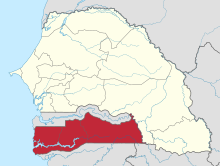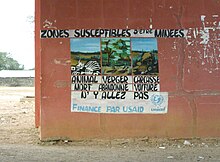Casamance conflict


The Casamance conflict was a military conflict fought by the Mouvement des forces démocratiques de la Casamance (MFDC) since 1990 to gain independence for Casamance from Senegal .
The region is the focus of settlement of the Diola ethnic group , who had a long tradition of striving for independence. The MFDC initially organized peaceful demonstrations for freedom. In 1982 the organization's leaders were arrested, creating a vicious circle of violence and counter-violence.
Armed violence broke out
In 1990, with the support of the Guinea-Bissau Armed Forces , the MFDC began attacks on military facilities in the region. The Senegalese army in turn attacked positions of the MFDC in the Ziguinchor region, traditionally known as "Basse Casamance", and in Guinea-Bissau. Both sides of the conflict are accused of attacking bystanders.
Numerous armistice agreements were signed in the 1990s, but none were permanent. The attack on four French tourists brought the conflict into the European headlines; both sides of the argument accused each other of being responsible.
With Augustin Diamacoune Senghor the MFDC got a leader who was looking for negotiated solutions again. As the Senegalese government continued to strictly reject the independence of the region, some members split off from the MFDC and began the armed struggle again.
Between 1997 and March 2001, around 500 people were killed in the fighting.
The government measures and plans to remove anti-personnel mines make it clear that the combat area was concentrated in the three departments of the Ziguinchor region and the Goudomp department of the Sédhiou region .
Search for negotiation solutions
When Abdoulaye Wade took office, the government's policy towards the separatists changed. While his predecessor Abdou Diouf relied on a military solution, Wade relied on negotiations. His efforts were supported by a change of power in neighboring Guinea-Bissau and the death of the long-standing chief of staff there, Ansumané Mané, in 2000. As a result, the separatists lost support in the southern neighboring country. Against this background, Senghor signed another agreement in March 2001, which provided for, among other things, the release of prisoners, the return of refugees and the clearing of the landmines . However, the agreement did not provide for autonomy . As a result, the MFDC split into two factions that fight each other. Wade also appointed two ministers from the Casamance to his government and also replaced the mayor of Ziguinchor with a man from the south. He also visited Casamance personally and negotiated with moderate representatives of the MDFC. He wanted to help integrate the residents of Casamance in Senegal better.
Since the split in the MDFC, the militant wing led by Salif Sadio has continued the fighting. By 2009 alone, they cost around 5,000 lives. The MDFC faction led by Sadio has been observing a "unilateral ceasefire" since around the beginning of 2015.
A new attempt to end the conflict was started in August 2011. Senegal's President Abdoulaye Wade asked his counterpart, President Yahya Jammeh , to mediate in this conflict on August 17th during a working visit to The Gambia .
The conflict was further defused after the end of the presidency of Yahya Jammeh in Gambia in early 2017. Wade's successor, Macky Sall , took advantage of the change in power with targeted diplomatic initiatives. As a result, the separatists also lost their support in the northern neighboring country. The conflict in the Casamance is mainly carried on by splinter groups of the MDFC who try to keep themselves afloat economically through a kind of banditry.
A massacre in the forest of Bourofaye near the municipality of Nyassia south of Ziguinchor on January 6, 2018, when 14 loggers were caught illegally collecting firewood and were mercilessly executed, is not associated with the MDFC by any side, but it has the good one Development of the security situation in the region set back again. The background to the bloody act is suspected to be cross-border activities of a “timber mafia”, which are making themselves unpopular with the population through illegal logging, especially since sacred forests play an important role in traditional religious rites such as kankurang or boukout .
Individual evidence
- ↑ Center nationale d'action antimines, April 2017: Actualisation du plan d'action de l'extension du Senegal 2016–2021 , PDF file 290 kB
- ↑ jeuneafrique of January 24, 2018: Salif Sadio, chef d'une branche du MFDC, menace de rompre la trêve en Casamance
- ↑ Senegal seeks Gambia's intervention in ending Casamance conflict ( Memento of October 12, 2011 in the Internet Archive ) The Daily Observer of August 17, 2011
- ↑ From Independence to Banditry: The Casamance Conflict. Amat Jeng, May 22, 2018 , from Dalarna University , Sweden
- ↑ Thomas Volk, Konrad-Adenauer-Stiftung, January 23, 2018: Wood mafia in Senegal? Blood deed in the Casamance and many questions
Web links
- BBC News, Dakar, December 30, 2004: Senegal to sign Casamance accord
- Department of Social Sciences at the University of Hamburg. Current Wars: Senegal (Casamance) ( Memento of December 7, 2008 in the Internet Archive ), last update: Nov. 25, 2008
- News and background about the Near and Middle East. January 21, 2010: Senegal - On the current developments in Casamance ( Memento from June 11, 2010 in the Internet Archive )
- Deutschlandfunk Kultur from April 10, 2013: The endless smoldering fire. The Senegalese troubled region of Casamance